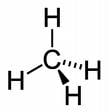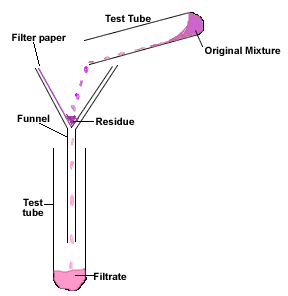Chemistry Trivia Quiz
(193).jpg)
Do you love chemistry? If you really love this subject, you will also like the chemistry trivia quiz we have here for you. Chemistry is all about elements, substances, and formulas. It's a subject that is either loved too much or hated too much. There is no mediocrity. As a child, you must have read chemistry, or maybe you study it now too. Let's see how much you really know. All the best to you.
- 1.
Which molecule is this?
- A.
Propane
- B.
Pentane
- C.
Methane
- D.
Butane
Correct Answer
C. MethaneExplanation
The molecule shown is methane (CH4), the simplest alkane and the main component of natural gas. It consists of one carbon atom bonded to four hydrogen atoms. Methane is a colorless, odorless gas that is widely used as a fuel source. It is also a greenhouse gas, contributing to climate change.Rate this question:
-
- 2.
Which pH would water be?
- A.
4
- B.
11
- C.
7
- D.
9
Correct Answer
C. 7Explanation
Water has a neutral pH of 7. This means that it is neither acidic nor basic. A pH of 4 indicates that the substance is acidic, while a pH of 11 indicates that it is basic. Therefore, the correct answer is 7, which represents a neutral pH for water.Rate this question:
-
- 3.
What is the test for Oxygen?
- A.
Relight a glowing splint
- B.
Burn with a squeaky pop
- C.
Turn lime water cloudy.
- D.
Explosion occurs
Correct Answer
A. Relight a glowing splintExplanation
Relighting a glowing splint is a test for oxygen because oxygen supports combustion. When a glowing splint is exposed to oxygen, it reignites because the oxygen present in the air reacts with the flammable material on the splint, allowing it to burn again. This reaction confirms the presence of oxygen.Rate this question:
-
- 4.
What is the symbol of potassium?
- A.
K
- B.
A
- C.
L
- D.
P
Correct Answer
A. KExplanation
The symbol of potassium is "k" because it is derived from its Latin name "kalium." In the periodic table, chemical elements are represented by symbols, and the symbol "k" specifically represents potassium.Rate this question:
-
- 5.
H2O stands for
- A.
Nitrogen
- B.
Oxygen
- C.
Iron
- D.
Water
Correct Answer
D. WaterExplanation
H2O is the chemical formula for water. The "H" represents hydrogen, and the "O" represents oxygen. Therefore, H2O stands for water.Rate this question:
-
- 6.
Water boils at
- A.
0-degree centigrade
- B.
10-degree centigrade
- C.
100-degree centigrade
- D.
130-degree centigrade
Correct Answer
C. 100-degree centigradeExplanation
Water boils at 100-degree centigrade. This is the standard boiling point of water at sea level. At this temperature, water changes from a liquid state to a gaseous state, forming water vapor. It is important to note that the boiling point of water can vary depending on factors such as altitude and impurities in the water. However, under normal atmospheric pressure, water boils at 100-degree centigrade.Rate this question:
-
- 7.
Electrolysis is the spitting up of an ionic compound by passing ______ electricity through it.
- A.
A.C
- B.
D.C
- C.
Both
- D.
None
Correct Answer
B. D.CExplanation
Electrolysis is the process of breaking down an ionic compound into its constituent elements by passing an electric current through it. In this case, the correct answer is D.C (Direct Current) because electrolysis requires a continuous flow of electrons in one direction to facilitate the chemical reactions necessary for the compound to split up. Alternating Current (A.C) would not be suitable for electrolysis as it constantly changes direction, preventing the desired chemical reactions from occurring effectively. Therefore, D.C is the preferred type of electricity for electrolysis.Rate this question:
-
- 8.
An ionic bridge...
- A.
Completes the circuit
- B.
Ends the circuit
- C.
Stops the circuit
- D.
None of these
Correct Answer
A. Completes the circuitExplanation
An ionic bridge completes the circuit by allowing the flow of ions between two electrodes. It acts as a conductor, connecting the two electrodes and enabling the movement of charged particles. This ensures the continuous flow of electric current in the circuit.Rate this question:
-
- 9.
Which method is being used here?
- A.
Evaporation
- B.
Distillation
- C.
Combustion
- D.
Filtration
Correct Answer
D. FiltrationExplanation
Filtration is a method used to separate solid particles from a liquid or gas by passing it through a filter medium. In this process, the solid particles are retained by the filter while the liquid or gas passes through. This method is commonly used in various industries and laboratories for purification purposes.Rate this question:
-
- 10.
What is in the center of an atom?
- A.
Nucleus
- B.
Element
- C.
Electron
- D.
Sodium
Correct Answer
A. NucleusExplanation
The correct answer is nucleus because it is the central part of an atom. It contains protons and neutrons, which make up most of the atom's mass. The electrons, on the other hand, orbit around the nucleus in energy levels. Sodium is an element, but it is not located in the center of an atom.Rate this question:
-
Quiz Review Timeline +
Our quizzes are rigorously reviewed, monitored and continuously updated by our expert board to maintain accuracy, relevance, and timeliness.
-
Current Version
-
Jan 20, 2025Quiz Edited by
ProProfs Editorial Team -
Nov 18, 2008Quiz Created by
Emmmmma
 Back to top
Back to top





